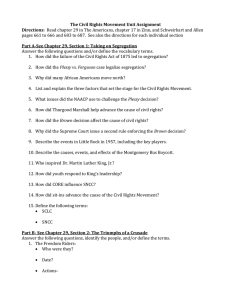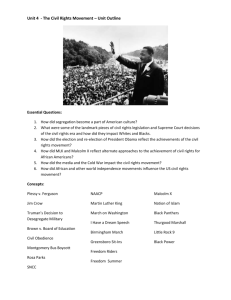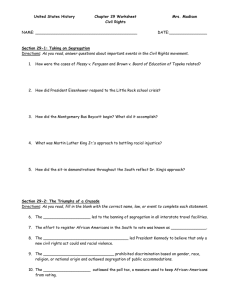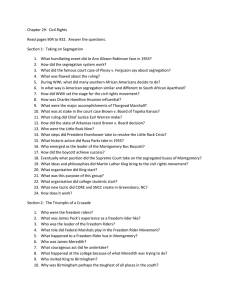The Civil Rights Movement - Public Schools of Robeson County
advertisement
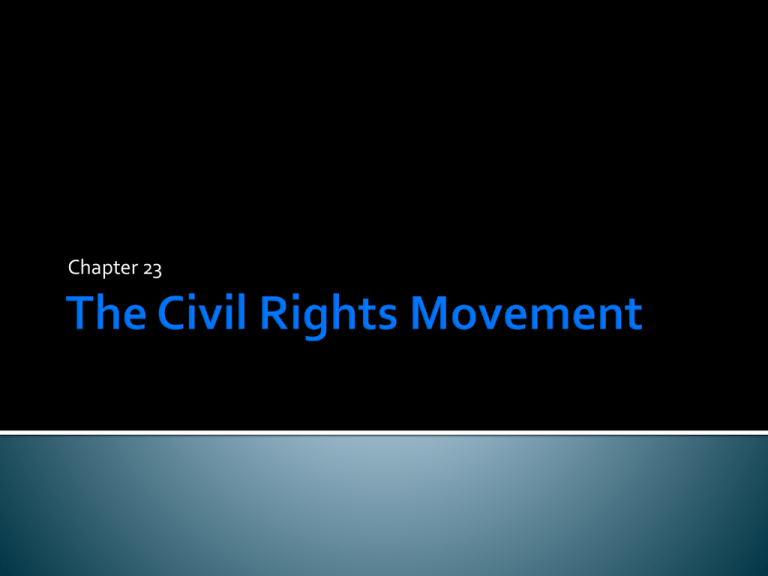
Chapter 23 Dred Scott v. Sandford (1857) Even though Dred Scott lived in the free state of Mississippi, he was still a slave. Slaves are ‘property’ and Congress did not have the power to seize a citizen’s property. Plessy v. Ferguson (1896) Segregation is permissible as long as the facilities are ‘equal’. Brown v. Board of Education (1954) Separate facilities are inherently unequal– cannot legally have them. De jure segregation Definition Example Part of the country De facto segregation - Segregation on the basis of laws - Jim Crow laws - Based on informal norms - Separation of races in regards to housing - South - North Who was Emmett Till? Where was he from? 14 year old African American from Chicago, IL What was he accused of doing? What does the article suggest actually happened? Accused of ‘flirting’ w/a white woman– actually dared by one of his friends to do so. What happens to Emmett Till? Kidnapped and brutally murdered; body thrown in the Tallahatchie River. How does his mother react to his murder? Very upset– allowed an open casket and pictures of her son’s body to be sent to Jet magazine for national attention. What evidence was there against Milam and Bryant? Eyewitness accounts What is the result of the trial? Found not guilty Montgomery Bus Boycott On December 1st, 1955 Rosa Parks refused to give up her seat to a white passenger, per Montgomery law. Boycott of the Montgomery buses left the transportation system crippled. Group Members Goal NAACP (National Association for the Advancement of Colored People African - Provide legal assistance to African Americans– Americans usually professionals SCLC (Southern Christian Leadership Conference) - Southern ministers SNCC -Young civil (Student Non-Violent rights Coordinating activists Committee) - Nonviolent resistance (esp. in the South) to fight injustice - Grassroots movement to coordinate all classes of African Americans to attain equality What did the members of the Little Rock Nine set out to do? Volunteered to be the first to enroll at newly desegregated Central High School. How did the state of Arkansas respond? What did President Eisenhower decide to do? Governor Faubus used the National Guard to blockade their way. President Eisenhower responded by sending in federal troops. What did the Little Rock Nine face when they were finally allowed to go to Central High? They were surrounded by hostility. They were yelled at, spat at and had to be escorted the entire year. What happened to the students at the end of the school year? One of the students became the first African American to graduate from the school. What were the students in Greensboro protesting? The inability of blacks to be served in white restaurants. What civil right were they exercising? Right to peaceably assemble. What tactic did they use? How did it work? Sit-ins nonviolent form of protest; students would remain seated until close of business. What was the outcome of the sit-ins? Gained student support– increased media attention. What did James Meredith set out to do? Did he have the right to do this? Become the first African American to attend Ole Miss. Yes– school desegregation included public universities. How did Mississippi Governor Barnett respond publicly? Tried to keep Meredith out– passed a law barring admission to those who had committed a crime. What secret deal did Governor Barnett make? With whom did he make the deal? Meredith would be allowed to enroll, only if accompanied by federal troops. Attorney General Robert Kennedy. How did southern newspapers react? Encouraged the hostility– documented the forced integration. How did white southerners respond? Rioting, violent mobs What was the outcome of Meredith’s attempt? Accompanied by federal marshals and troops. Allowed to attend. In the end, what happened to James Meredith? Graduated in 1963; later assassinated. What was the goal of the March on Washington? To show support for a new civil rights bill. Who marched on Washington? All the civil rights groups and members of labor unions and religious groups. Why did civil rights leaders choose D.C. for their march? Public attention– stage of the legislative debate. What was King’s dream? “All men are created equal” Passed by: Lyndon Johnson The Act banned: segregation in public accommodations. Goal register as many African Americans to vote as possible. Goal pressure federal government to enact voting rights legislation The March attempts to cross the bridge into Selma was met with armed troops. Led by MLK and members of SCLC. President Johnson publicly criticizes the event. Results 24th amendment Banned the poll tax. What did the Freedom Riders set out to do? Target interstate transportation, where segregation had just been ruled illegal. Who were the Freedom Riders? Members of CORE– 6 whites and 7 African Americans. What happened to the first bus on its way to Birmingham? Firebombed What happened to the second bus? Attacked by a mob How did the local police respond? Arrested and sent the riders to jail Leader Dr. Martin Luther King Jr. Malcolm X Stokely Carmichael Bobby Seale and Huey Newton Group Main Idea Tactics SCLC Against physical and emotional violence Nonviolent protests Nation of Islam Believed in separation of the races Nonviolence “black power”– young African Americans who followed Malcolm X Equality can only be achieved when all blacks unite. Black power= black violence Black Panthers Young militancy Violence– embracing of African American heritage Where did the race riots break out? Los Angeles, CA What were the results of the race riots? Death and destruction of poverty. What did people think was the cause of the riots? Racial violence by blacks. What did the Kerner Commission discover as the real cause of the riots? Growing discord over discrimination. Malcolm X killed by three members of the Nation of Islam after a pilgrimage to Mecca (Islam holy land) Dr. Martin Luther King, Jr. killed in Memphis while supporting a sanitation workers’ strike. Civil Rights Act of 1968 Also known as the Fair Housing Act; Fair housing practices; could not discriminate on the basis of race, faith or national origin. Voting Rights Acts Amended the VRA of 1965– strengthened and made it more widespread. Affirmative action– reverse discrimination? Issue of busing Should it be used as an integration tool? Swann v. Charlotte-Mecklenburg County Schools (1970) Integration of schools ‘Poorer’ neighborhoods have ‘poorer’ schools are all schools equal?
